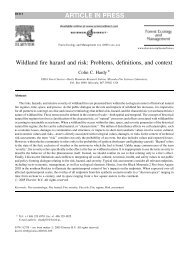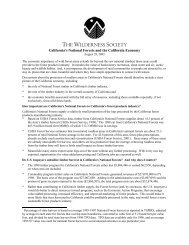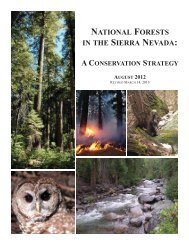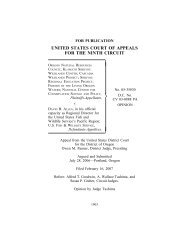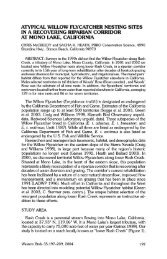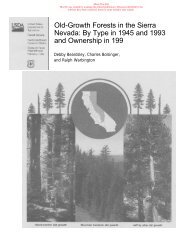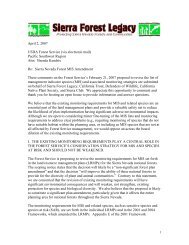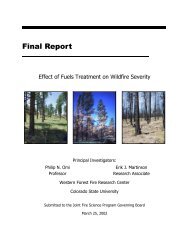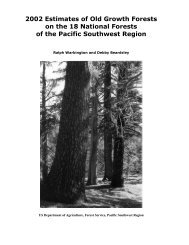1014VOLUME II, CHAPTER 36TABLE 36.3 (continued)Activity and Potential Direct Physical Effects Potential Ecological Consequences ReferencesRoad and Railroad ConstructionRailroads and highways often follow rivers, built along Riparian habitat replaced by railroad or highway for long Scheidt 1967banks of riverdistances along one bankRailroads and highways cross rivers Continuity of riparian corridor interrupted by gaps Furniss et al. 1991at crossingsFailure of roads and culverts delivers sediment <strong>to</strong> channel Sediment reduces invertebrate habitat and populations Erman et al. 1977UrbanizationSettlement along riverbanks and on bot<strong>to</strong>mlands Riparian habitat replaced by urban infrastructure Medina 1990Increased impervious surface upstream increases peak Water table may fall with incising channel, resulting in Dunne and Leopold 1978;runoff, induces channel widening, incision moisture stress <strong>to</strong> vegetation Booth 1990Land drainage <strong>to</strong> make land suitable for development Desiccation of riparian vegetation National Research Council1992Channel relocation or channelization for flood control Engineered channel margins rarely provide suitable Brookes 1988conditions for establishment of riparian vegetationGrazingLives<strong>to</strong>ck trample and compact banks Prevent establishment of vegetation, crush amphibians Armour et al. 1991; Chaney etal 1990; Jennings 1996Lives<strong>to</strong>ck hooves chisel banks Destroy existing vegetation, destroy undercut banks, USFS 1995; Over<strong>to</strong>n et al.contribute <strong>to</strong> channel widening1994; Kondolf 1994cLives<strong>to</strong>ck browse seedlings Recruitment of young woody riparian plants prevented Platts 1991Removal of vegetation and compaction in watershed leads Erosion of banks supporting riparian vegetation Behnke and Raleigh 1979;increased peak runoff and erosion, possibly <strong>to</strong>Platts 1991; Dudley anddecreased <strong>to</strong> base flow Dietrich 1995Previously listed fac<strong>to</strong>rs lead <strong>to</strong> incision of channels, Water table drops, desiccating wetland species Odion et al. 1990especially in meadowsLack of bank vegetation and undercut banks, channel Reduced fish populations, reduced invertebrate Behnke and Raleigh 1979;widening,and higher water temperatures populations Armour et al. 1991;Herbst and Knapp 1995Groundwater AbstractionGroundwater pumping lowers alluvial water table Water table may fall below root zone of riparian plants, Kondolf and Curry 1986inducing moisture stress or deathRecreationHeavy foot traffic tramples vegetation, compacts soil, and Loss of riparian vegetation, creation of bare banks prone Liddle 1975; Madej et al. 1994physically damages bank<strong>to</strong> erosionTrails (foot, horse, bicycle, mo<strong>to</strong>rcycle) often follow Riparian vegetation removed and replaced by trail; Holmes 1979; Lemons 1979streamscontinuity of riparian corridor interrupted at crossingsits tend <strong>to</strong> occur in wider alluvial reaches, and thus mining isconcentrated in foothill and valley reaches of <strong>Sierra</strong>n rivers,although mines are also active along the upper reaches of theFeather and Yuba Rivers (California State Lands Commission1993) and the American River (Kondolf and Matthews 1993).Dams have direct effects from the permanently removal ofriparian habitat <strong>to</strong> construct roads, pens<strong>to</strong>cks, powerhouses,canals, and dams. Reservoirs drown existing riparian vegetation,and fluctuating water levels usually prevent the establishmen<strong>to</strong>f comparable new vegetation stands along reservoirmargins. Thus, reservoirs constitute significant gaps in theriparian corridors. The largest reservoirs are located in thefoothills, but reservoirs large enough <strong>to</strong> constitute significantgaps occur at virtually all elevations, as reflected in plots ofreservoirs by elevation for the Sacramen<strong>to</strong> and San JoaquinRiver basins (figures 36.1 and 36.2). Maps of reservoir numbersand capacity by watershed reflect the widespread occurrenceof reservoirs throughout the range, with greater capacityin the central <strong>Sierra</strong> Nevada (figure 36.3).Indirect effects of dams derive from changes in the flowregime and sediment load on downstream channels. Reductionin floods leads <strong>to</strong> reduced rates of channel migration(which in turn reduces the diversity of riparian habitats) and<strong>to</strong> the encroachment of vegetation in<strong>to</strong> (and thus the narrowingof) the active channel. Most vegetation encroachment andchannel narrowing in <strong>Sierra</strong>n rivers has been <strong>report</strong>ed belowlarge reservoirs in the foothills (Pelzman 1973), whose s<strong>to</strong>rageis adequate <strong>to</strong> substantially reduce flood flows. Large reservoirsare less common but do occur at higher elevations.Most have not been studied, but many would likely evinceencroachment and narrowing downstream, as observed onthe North Fork Kings River (Taylor and Davilla 1985).By s<strong>to</strong>ring water during winter and spring for subsequentrelease, reservoirs can increase base flows, which can, in turn,waterlog riparian vegetation accus<strong>to</strong>med <strong>to</strong> well-drained conditionsin late summer and fall. Summer base flows on theNorth Fork Stanislaus River have increased tenfold as a resul<strong>to</strong>f s<strong>to</strong>rage in a hydroelectric project, and mortality of manyriparian trees has been predicted (Parrish and Matthews 1993).Where reservoir water is exported from the basin, base flowscan be reduced. On Rush Creek, the principal tributary <strong>to</strong>Mono Lake, no regular base flow releases were made from
1015Status of Riparian HabitatGrant Lake Reservoir from 1941 <strong>to</strong> 1981, and a massive dieoffof woody riparian vegetation ensued (Stine et al. 1984).Reservoirs also trap the coarser (sand and gravel) portionof the sediment load and some fraction of the suspended load(depending upon the capacity of the reservoir relative <strong>to</strong> inflow).As a result, reservoir releases are typically sedimentstarved—they have the energy <strong>to</strong> transport sediment but aredeprived of this load. As a result they tend <strong>to</strong> erode their bedand banks (Williams and Wolman 1984). If the channel incises,the alluvial water table will probably drop, resulting inmoisture stress for the riparian vegetation adapted <strong>to</strong> the previouswater table.Hydroelectric generation entails most of the effects of damswhere s<strong>to</strong>rage is involved, but has a somewhat different suiteof effects if the project involves diversion but no s<strong>to</strong>rage—arun-of-the-river project (figure 36.4). Small diversions are commonin the <strong>Sierra</strong> Nevada, either for small run-of-the-riverprojects, or for seasonal diversion via tunnels in<strong>to</strong> s<strong>to</strong>ragereservoirs in adjacent drainages (see Kattelmann 1996).Irrigation usually involves s<strong>to</strong>rage reservoirs so that wateris available during the growing season. Thus, irrigationprojects typically involve many of the same effects as thosedescribed for dams, and because they cause a net decrease inriver flow, irrigation projects dewater river reaches. Small fishcan be pulled in<strong>to</strong> unscreened diversions and killed when theyare discharged on<strong>to</strong> agricultural fields. Excess irrigation watercan support riparian vegetation in artificially created wetlands,fed either by surface flows or groundwater rechargedby excess irrigation waters. Along Rush Creek in Mono Basin,excess irrigation water infiltrated in<strong>to</strong> permeable bedrockand reemerged downstream as springs. This process maintainedhigh water tables, reestablished perennial flow, andthereby supported riparian vegetation even when diversionhad completely dried the channel upstream (Kondolf andVorster 1993). The combination of dams and diversions resultsin impacts in the majority of watersheds of the <strong>Sierra</strong>Nevada (figure 36.3d). Although few large dams are found inthe northern region of the study area, this region has in generala higher density of diversions than other regions.Most large irrigation s<strong>to</strong>rage reservoirs on <strong>Sierra</strong>n riversare in the foothills; irrigation diversion from Friant Dam anddownstream diversions completely dries up the San JoaquinRiver annually at Gravelly Ford. Seasonal diversions withouts<strong>to</strong>rage were used <strong>to</strong> irrigate farmland on the Bishop Creekalluvial fan by Native Americans and subsequent Europeansettlers. These irrigation canals now support lush riparianvegetation (Federal Energy Regula<strong>to</strong>ry Commission 1986). Aseasonal irrigation diversion on the Little Truckee River reducedflows and resulted in channel widening downstream(Erman 1992).Land drainage (usually for agriculture or urbanization) resultsin desiccation of wetland plants. Drainage of formermeadows has been common around Lake Tahoe, resulting inloss of many riparian plants and invasion by upland species.Probably the most widespread land drainage in the <strong>Sierra</strong>Nevada has been in wet meadows, which have been draineddeliberately (documented as early as the 1870s, as in the dynamitingof a moraine in Yosemite Valley by Galen Clark <strong>to</strong>drain upstream meadows) (Greene 1987) and inadvertentlybecause of channel incision (generally attributed <strong>to</strong> effects oflives<strong>to</strong>ck grazing) (e.g., Odion et al. 1990).Land clearance for agriculture has been most common in widealluvial reaches in the foothills and Central Valley, where formerlyextensive bot<strong>to</strong>mland forests were cleared, leaving onlya narrow band of riparian vegetation (if any) along the bank.Removal of vegetation was undertaken in the southwesternUnited States, mostly on an experimental basis, <strong>to</strong> reducewater “losses” <strong>to</strong> evapotranspiration by phrea<strong>to</strong>phytes. Althoughsome phrea<strong>to</strong>phytes were eliminated in the <strong>Sierra</strong>Nevada (Biswell 1989), the environmental impacts of this practice(Campbell 1970) are generally acknowledged <strong>to</strong> be <strong>to</strong>ogreat <strong>to</strong> justify it. Nonetheless, an increased water yield anticipatedas a result of forest harvesting (mostly upland) hasbeen fac<strong>to</strong>red in<strong>to</strong> the national forest planning process inCalifornia. The Sequoia National <strong>Forest</strong> attributed 30% of the“benefits” from its preferred alternative of the latest forestplan <strong>to</strong> the supposed value of increased water expected as aby-product of timber harvest (U.S. <strong>Forest</strong> Service 1988).Navigation by large ships commonly requires channeldredging and straightening, mostly undertaken in lower, valleyreaches of rivers, downstream of the study area.Timber harvest affects riparian vegetation directly and indirectly.Riparian vegetation has been removed in harvests ofbot<strong>to</strong>mland forests, and the construction of logging roadsalong bot<strong>to</strong>mlands replaces riparian vegetation with roadsurface. Past log drives down rivers resulted in extensive batteringof banks, reducing habitat complexity along the water’sedge. Removal of timber on hill slopes, along with road constructionand skid trail compaction, typically results in increasedpeak runoff and increased erosion. These so-calledcumulative effects can degrade aquatic habitat and can potentiallylead <strong>to</strong> the erosion of banks supporting riparian vegetationand the conversion of well-vegetated valley bot<strong>to</strong>msin<strong>to</strong> wide, open, gravel bed channels (Grant 1988; Lyons andBeschta 1983).Timber harvest has been extensive in the <strong>Sierra</strong> Nevada.Riparian trees, notably giant sequoia and other old-growthstands on bot<strong>to</strong>mlands of <strong>Sierra</strong>n rivers have been harvested,directly affecting bank vegetation and aquatic habitat.Franklin and Fites-Kaufmann (1996) found that 95% of the1,200 ha (3,000 acres) separately mapped as riparian hardwoodforest type had no late successional/old growth characteristicsleft, although deep, inaccessible river canyons withother forest types contained some of best remaining examplesof old growth. Given that average angular canopy densities(canopy measured at an angle that effectively blocks summersun) of 75% were observed on unlogged first- and secondorderchannels in the northern <strong>Sierra</strong> Nevada (Erman et al.1977), removal of riparian trees has a tremendous effect onaquatic habitat.
- Page 1 and 2: G. MATHIAS KONDOLFDepartment of Lan
- Page 4 and 5: 1012VOLUME II, CHAPTER 36TABLE 36.1
- Page 8 and 9: 1016VOLUME II, CHAPTER 36Elevation
- Page 10 and 11: 1018VOLUME II, CHAPTER 36FIGURE 36.
- Page 12 and 13: 1020VOLUME II, CHAPTER 36FIGURE 36.
- Page 14 and 15: 1022VOLUME II, CHAPTER 36Frequency
- Page 16 and 17: 1024VOLUME II, CHAPTER 36conditions
- Page 18 and 19: 1026VOLUME II, CHAPTER 36we can inf
- Page 20 and 21: 1028VOLUME II, CHAPTER 36Hicks, T.
- Page 22: 1030VOLUME II, CHAPTER 36Schimer, F



